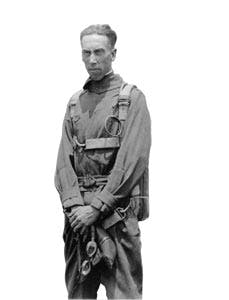In 1910, a recent graduate of the Curtiss Flying School, Otto Brodie, needed a mechanician to keep his Curtiss pusher in one piece while he made exhibition flights in the Midwest. Based at Chicago’s Cicero Field, he was fortunate enough to meet Rudolph William Schroeder. At 6 feet 4 inches tall, Schroeder was already known for his mechanical skills. He was otherwise described as a “serious, sad looking man who played a fine accordion.” Brodie is said to have nicknamed him “Shorty.”
Born in Chicago on Aug. 14, 1885, Rudolph William (“Shorty”) Schroeder was a gifted student who progressed through educational training at Crane Technical School. He was experimenting with his own glider designs in 1909, just prior to meeting Brodie.
Although of different backgrounds, they were a good match. Schroeder’s mechanical skills kept Brodie flying, but the Curtiss did not last long, and in 1911 Brodie acquired a used Farman aircraft with a 50-hp Gnome engine from wealthy New York aviator, Clifford Harmon. The Farman carried with it a legacy of fame worthy of its own distinction in aviation history. Schroeder added metric tools to his trade and got his hands greasy on the Gnome, aviation’s first air-cooled, rotary engine. Brodie made hundreds of exhibition flights in the Midwest, and used the Farman at his aviation school in both Florida and Illinois. Along with him was “Shorty” Schroeder, mechanician.
Touched by fame
Today, the unmistakable sound of a rotary engine elicits nostalgic affection from a vintage aviation enthusiast. However, the Gnome’s inner beauty may not have been immediately obvious to Schroeder in 1911. “In this type of engine, the crankshaft is mounted on the airplane, while the crankcase and cylinders rotate with the propeller,” writes engine historian Matt Keveney. When he initially learned how they worked Keveney’s reaction was, “the only person crazier than the engine designer was the one who paid money for it. At first glance it seems ridiculously backwards.”
Driven by France’s great passion for aviation, siblings Louis and Laurent Sequin created the first practical challenge to water-cooled engines based upon their automobile and marine power plants manufactured near Paris. They named it the “Gnome,” after a hard working, small mythical creature which guarded underground treasure. By 1909, they convinced their country’s most famous aviator, Louis Paulhan, to affix Gnome Omega #1 to his Farman aircraft. During 1909 and 1910 Paulhan thrilled spectators at air meets in Europe and the United States. He flew his Farman (with a new Gnome engine) in the 1910 Los Angeles International Air Meet at Dominguez Hills, CA. It was this Farman and the unique and perplexing Gnome engine which eventually came under the care of Schroeder for three years.
According to Keveney, the Gnome’s advantages over water-cooled engines were less weight (under 170 pounds), better balance, and no flywheel. In the air, aviators dealt with the disadvantage of a gyroscopic effect making the plane more difficult to maneuver; the total loss of oil (mixed with gasoline) also limited the length of time it could run. Castor oil was often used, which flew back toward the open cockpit, covering the face of the aviator. The early aviator’s white neck scarf which flowed in the wind was used to wipe off the caster oil which had not already been swallowed. Added to the stress of a flight in a noisy machine made of wood and fabric, aviators had to contend with the inevitable unwelcome laxative. Used on several other types of aircraft, the Gnome Omega “gracefully bowed out in 1911,” according to Marina Dal Sogilio, an archivist at Snecma Moteurs, leaving behind a legacy as the “mythical Omega, an engine that revolutionized international aviation in its time.”
Gnome #755
The Minnesota Air & Space Museum (MASM) located in Blaine, MN, fell heir to a 1909 Gnome Omega 50-hp engine, nearly identical to that which Schroeder maintained for Brodie. The museum’s president and chief mechanic, Denny Eggert, yearned to bring it to life. Eggert has repaired almost anything requiring a power plant for more than 40 years but needed an expert on rotary engines. He hired Fred Murrin of Greenville, PA, known to have built vintage planes from the grass up, who soon had the engine restored, inspected, and ready for a trial run. Now on display at the MASM, the Gnome Omega (Serial #755) is affixed to a test stand and started up once a year for fund-raising purposes. Eggert is at the mag switch each time. “The Gnome is a remarkably quiet engine ... a lot more quiet than an Anzani,” he says, “but I tell you, when you hear that sound it gives you chills down your spine.”
The Farman which Brodie flew under Schroeder’s care had no full throttle nor did it have brakes. The Gnome’s rpms were controlled by an instrument called a “blip switch” which shut off three out of the seven cylinders and decreased the power. A precision landing was achieved by backing off intermittently on engine power using the blip switch, and heading for a place where you could roll for several feet until you were dragged to a stop by the tail skid which dug into dirt and grass (or the occasional inanimate object).
The exhibition circuit
During a routine test flight in 1913, Brodie lost control of his Farman and was crushed to death by the Gnome engine which broke loose from the impact of the crash. He was 25.
Schroeder then hooked up with aviator Mickey McGuire, who flew a Curtiss Pusher. Within a year, McGuire was also killed, leaving Schroeder to finish the season making exhibition flights of his own, and working for other fliers as a mechanician.
For a while he worked for Katherine Stinson, affectionately known as the “Schoolgirl of the Air” who thrilled spectators with loops and night flights in both the United States and Japan. A fellow aviator described meeting Stinson and Schroeder in 1916, just before she made one of her famous night flights with lighted flares on her Wright biplane.
“Across the field through the darkness … Katherine and her mechanic, Shorty Schroeder were preparing for her flight ... She appeared perfectly calm as she and her mechanic checked over the plane, revved up the motor to be sure it was running properly, and making sure that the magnesium flares which were attached to the edge of the lower wings were secure. She could well feel confidence in her capable mechanic because he was none other than Rudolph “Shorty” Schroeder ... she was fortunate enough to be able to persuade him to be part of her team. He was all business as he tested wires, controls, etc. Soon a megaphone announced [her flight] ... Shorty spun the wooden propeller with one swing to start the motor and signaled Katherine away ...”
When Stinson landed Schroeder was waiting for her near their bonfire. After a fireside chat, Schroeder staked the plane down, and covered it with canvas for the night. He would be back at dawn preparing for the next show on the road.
Many “early birds” lived long and relatively healthy lives, but during 1913, in addition to Brodie and McGuire, Cicero Field also lost two popular local aviators: Max Lillie and Andrew Brew. Exhibition flying did not fill the ambitions of Schroeder, however, and he soon enlisted in the U.S. Army Signal Corps, eager to be among the first Reserve Military Aviators at the onset of WWI.
“The Peace Time Ace”
“[Schroeder’s] adult life spanned the whole period of commercial and military aviation, to which he made great contributions at great personal cost.” Chicago Tribune, 12/31/52
McCook Field near Dayton, OH, where dozens of famous military aviators began their career, was operated as an airfield, training field, and test station from 1917-1927. Among the aviators was “Shorty” Schroeder, who advanced to the rank of Major within two years, assigned as chief test pilot. Perhaps influenced by the deaths of fellow exhibition fliers, Schroeder focused on safety features for aviators, favoring the new parachute designed by Floyd Smith. Schroeder was the first military aviator to wear Smith’s parachute pack in 1919, and was the first instructor to open a night-flying school for military instruction. He made altitude records during the fall of 1919, in a Lepere biplane built by Packard Motor Car Company (which used a Liberty engine.) One of his attempts at the altitude record is well described as a near death experience, on Feb. 27, 1920:
“After climbing for an hour and 47 minutes to an altitude of 33,114 feet with a temperature of -6 F, Schroeder began to suffer from oxygen deficiency and carbon monoxide poisoning from the engine’s fumes. When he raised his goggles for a moment to locate his emergency oxygen supply, the film of moisture between his eyelids and his eyeballs froze. He attempted to put the plane into a gentle descent, but instead fell in a vertical dive and passed out. He regained consciousness after diving nearly six miles and was able to pull out an altitude of 2,000 feet. “
As a result of this flight, Schroeder’s vision was slightly impaired for the remainder of his life. The accident did not diminish his passion nor his ability to fly. In the summer of 1920 he flew the Air Service Corp.’s Verville-Packard aeroplane in the Gordon Bennett Race at Paris. Forced down by an overheated engine, his team did not finish.
When Schroeder stepped out of uniform, he went to work at Ford Airport in Detroit. Henry Ford’s design engineer, William Stout, was developing the Ford Tri-Motors which were to become the first commercial aircraft to regularly carry passengers across the United States. In order to demonstrate the safety of air travel and boost sales of his Tri-Motors, Henry Ford sponsored the “Ford Reliability Tour” in 1926, in which 23 planes flew 2,500 miles over a predetermined circuit. Schroeder was chosen to command one of Ford’s Tri-Motors, yet again was forced down and did not finish when he lost two of the three engines. A VIP on board later described the emergency landing in Nova, OH, as “gentle,” a testament to Schroeder’s steady nerve and skill.
From Detroit, Schroeder returned to Chicago employed by Curtiss-Wright, and in 1937 was appointed assistant director of the Bureau of Air Commerce. He was described in a contemporary newspaper article as “one of the few Bureau men whom everybody admires.”
From this time forward, Schroeder’s contribution to aviation was on the ground instead of in the air, developing airports, flying schools, and supporting the design of safer aircraft and equipment for pilots. In 1940 he became vice president of safety for United Airlines. Just one year into the job, he had a stroke from which he never fully recovered. Infirm, he continued to work on aviation projects from his sick-bed. In 1945, Schroeder was awarded the Distinguished Flying Cross for experiments in high altitude flying. On his 67th birthday in August of 1952 he was honored at Chicago’s airport by fellow aviators. No doubt there was the sound of an accordion at the party. He died four months later. Mechanician and flier “Shorty” Schroeder cast a long shadow in aviation history.
Giacinta Bradley Koontz is an aviation historian and author. She was the founder and director of the Portal of the Folded Wings Shrine to Aviation and Museum from 1995-2001 (the site of Charles Taylor’s grave in North Hollywood, CA). Giacinta holds a BA in anthropology with a minor in U.S. history and has given presentations on pioneer aviation since 1995. Most recently she has been awarded a partial grant from the Wolf Aviation Fund to write her second book, highlighting the life of Amelia Earhart’s mechanic, Ernest Eugene Tissot Sr.



